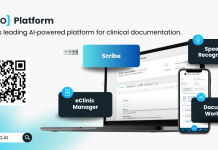Digital technologies can enhance infection detection and patient safety, but risk creating two-tier health systems that exacerbate existing inequalities. This article explores approaches to digital health equity to help bridge this gap
Infection prevention and control (IPC) is an evidence-based approach that prevents patients and health workers from being harmed by avoidable infections. IPC has long served as a cornerstone of safe healthcare delivery. From standard hygiene practices to surveillance systems and antimicrobial stewardship, IPC strategies are essential in limiting healthcare-associated infections (HAIs) and safeguarding patient safety. However, the COVID-19 pandemic highlighted the vulnerabilities within global health systems, particularly the unequal capacity to respond to infectious threats. It also accelerated the adoption of digital and data-driven technologies, but raised critical questions around equity, access, and sustainability. (1) As healthcare moves into a more digitally dependent era, there is an increasing need to align IPC efforts with the ethical imperative of equitable access. Nowhere is this more pressing than in low- and middle-income countries (LMICs), where digital health innovations, while promising, risk exacerbating existing disparities in access to care.
The role of digital technologies in IPC
From a system-wide vantage point, digital tools have revolutionised IPC strategies by enabling real-time monitoring, predictive modelling, contact tracing, and decision support systems. For example, Machine Learning algorithms can detect early signs of infection outbreaks by analysing hospital admission records or laboratory data, triggering timely interventions, as was observed at scale during the pandemic. (2) Moreover, smart hospital infrastructure can monitor hygiene compliance, temperature patterns, and ventilation, which are crucial elements for mitigating infection risks within confined spaces.
From a patient-driven perspective, telemedicine platforms can play a preventive role, for example, by reducing unnecessary hospital visits, thereby limiting potential exposure in clinical environments. Additionally, when individual electronic health records (EHRs) are integrated with infection alerts, they can contribute to early detection and rapid clinical response, thereby reducing morbidity and mortality. However, the effectiveness of these technologies is predicated on mature foundational infrastructure – interoperable health systems, reliable internet connectivity, trained personnel, and secure data governance – which are not evenly distributed across countries or even regions within countries.
The equity challenge
Digital health solutions often mirror the digital divide. Specifically, high-income countries can have rapidly implemented AI-driven surveillance tools within their advanced hospital infrastructure, whereas several LMICs may struggle with basic IPC capacity. Even within high- income settings, disparities exist among rural, minority, or socioeconomically disadvantaged populations. To address this challenge, IPC should not be viewed as a standalone, siloed field, but as part of a broader health digitization and digital health equity agenda. This includes ensuring access to devices, providing digital literacy training for healthcare workers, and investing in scalable, context-appropriate technologies. Without this, new tools may reinforce existing inequalities, creating ‘two-tier’ health systems, where only some benefit from technological innovations.
Importantly, equitable access is not simply a logistical or financial challenge – it is also a normative one. Digital technologies used in IPC often process sensitive patient data, raising ethical concerns around consent, privacy, and discrimination. Robust legal frameworks and transparent regulatory oversight are required to ensure that innovations do not compromise rights or entrench biases, especially when deployed in vulnerable populations. To address this, there is a pressing need for inclusive governance models that involve communities in the co-design and implementation of digital IPC tools. This community engagement fosters trust and ensures that, through community feedback, any solutions are locally relevant and culturally acceptable, particularly critical in LMIC settings where public health interventions have historically been top-down and externally imposed.
An example from oncology: infection control through remote chemotherapy monitoring
The oncology sector presents a compelling example of how digital technology can enhance IPC while simultaneously posing equity challenges. Cancer patients, especially those undergoing chemotherapy, are highly immunocompromised and thus at elevated risk of infection. Traditionally, their treatment requires frequent hospital visits, increasing exposure risks. To address this challenge, some health systems have introduced remote chemotherapy monitoring platforms. These systems enable patients to self-report symptoms, monitor vital signs, and receive personalised care recommendations without the need for a clinic visit. In Europe, for instance, a multi-site programme is ongoing where digital monitoring tools enabled clinicians to track neutropenic sepsis risk in real-time, a life-threatening infection associated with chemotherapy, reducing hospital-acquired infections and improving patient outcomes. (3)
However, the success of such platforms depends on patients having access to smartphones, reliable internet, and the skills to use them. In rural or underserved populations, these prerequisites are often unmet, risking digital exclusion. Thus, to ensure equitable access, initiatives such as ‘digital health navigators’ have emerged, helping patients use technology safely and effectively. (4) Looking forward, such programmes must be scaled and embedded into cancer care pathways as standard practice – not add-ons – if equity is to be achieved.
As the global health community grapples with future pandemics and antimicrobial resistance, IPC must be reimagined through the lens of digital equity. The convergence of IPC and digital innovation holds immense promise, provided it is pursued with a commitment to equity. However, this aspiration would require capacity building through dedicated digital training for healthcare professionals and patients, as well as an inclusive design that enables the latter to adopt and operate these new technologies. It is likely that scaling up such initiatives may require public-private collaborations (especially in LMICs) to develop affordable and scalable technologies. Ultimately, these attempts would need to be supported by appropriate guidelines and policy frameworks across digital health, IPC, and equity domains.
References
- Al Knawy, Bandar, et al. ‘Successfully implementing digital health to ensure future global health security during pandemics: a consensus statement.’ JAMA Network Open 5.2 (2022): e220214-e220214.
- Aisyah, Dewi Nur, et al. ‘The use of a health compliance monitoring system during the COVID-19 pandemic in Indonesia: evaluation study.’ JMIR Public Health and Surveillance 8.11 (2022): e40089.
- Maguire, Roma, et al. ‘Real time remote symptom monitoring during chemotherapy for cancer: European multicentre randomised controlled trial (eSMART).’ BMJ 374 (2021).
- Hughes, Gemma, et al. ‘Protocol: How can people with social care needs be supported through processes of digital care navigation to access remote primary care? A multi-site case study in UK general practice of remote care as the ‘new normal’.’ NIHR Open Research 3 (2023): 17.











